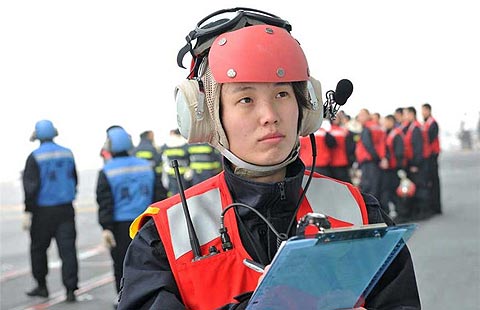China's space exploration goals before 2020
Updated: 2014-03-10 21:44
(Xinhua)
|
||||||||
China's steps in future space exploration
BEIJING - In near future, in outer space, Chinese scientists and their international colleagues, perhaps in the company of robots, will seek knowledge in labs on China's future space station.
Aboard the space station, deep in space, researchers will probe the profound mysteries of the universe, while explorers penetrate the darkness beyond both Moon and Mars.
This is no sci-fi movie, but a vision of the future presented to the people' s congress and members of the CPPCC during the two sessions. The vision is of a "space odyssey" for China' s future and for space exploration.
CHINA'S FUTURE SPACE STATION
By the year of 2020, the International Space Station is expected to be retired, while, in that same year, China's space station should be complete. China's station may then be mankind's only foothold in space.
Zhang Bonan, chief designer of the program, told Xinhua that the station will be multi-cabin with a large capacity and high power. "The 2020 space station will be a national space lab," Zhang said.
"Experiments there will be diverse and flexible," he said, "International cooperation will be encouraged and the door of the lab will open for any experiments that fit the requirements."
NEW FLIGHT SYSTEM
The first step to the stars is new technology, principally in supply lines. A cargo ship named "Tianzhou" (Heavenly Vessel) is planned to ferry cargo back and forth to the station.
China is expected to launch a cargo ship around 2016 to serve the Tiangong-2 space laboratory, said Zhou Jianping, chief designer of the manned space program and member of the National Committee of the CPPCC.
The cargo ship will be delivered into space by the new Long March-7 carrier rocket and dock with Tiangong-2 automatically, Zhou said.
A cargo transportation system that supplies goods and propellants is key to China building its own space station, he said.
Liang Xiaohong, Party chief of the China Academy of Launch Vehicle Technology, also a member of the National Committee, explained that the Long March carrier rocket series is already industrialized. By 2020, China will meet a market demand of more than 270 domestic and 460 foreign launches.
The Tianzhou cargo ship and the Long March rocket will be ready around 2016, heralding a new era in space transportation. Moreover, China is expected to launch a "space shuttle bus" this year to carry payload.
The "space shuttle bus", Yuanzheng-1 (Expedition-1) is an upper stage aircraft attached to a carrier rocket. It can carry spacecraft, using its own power, into an initial orbit, Liang Xiaohong said. It has the same function as a carrier rocket and can take multiple craft to different locations, Liang said.
Yuanzheng-1 will play an important role in future moon and Mars exploration as well as orbital transfer and space debris clearing, he said.
From the Earth to the Moon
While the Jade Rabbit moon rover sleeps on the moon, other dreams are taking wing.
Preparation for the 2017 launch of lunar probe Chang'e-5 is going as planned, said Ye Peijia, a top scientist with the Chang'e-3 lunar probe mission.
Chang'e-5, as part of China's third-phase lunar program, is expected to bring back moonrock samples to Earth, which Ye believes will be "a historic moment".
The more sophisticated Chang'e-5, including unmanned sampling and returning, requires breakthroughs in moon surface takeoff technology, sampling encapsulation, rendezvous and docking in lunar orbit, as well as high-speed Earth reentry.
To make sure the mission is a success, a Chang'e-5 test probe will be launched this year to rehearse the route, Ye disclosed.
Chang'e-2, launched on Oct. 1, 2010, is now China's first man-made asteroid, about 70 million km from Earth and heading into deep space. Ye said the ship could travel as far as 300 million km from Earth. "New discoveries cannot be ruled out," Ye said.
"We plan to send a manned mission to the moon. The Earth is our cradle, and humanity will go out from here someday. The moon is the nearest: if we cannot land on it, where else can we go?" he said.
THE MARTIAN CHRONICLES
China now has the capability to explore Mars by sending a probe to circle the planet and land, Ye said. The only question is when.
Humanity has launched more than 40 missions to planets in the solar system and over half of them have failed.
Zhang Bonan said that the logjam for a manned mission to Mars is still the technology.
"Exploration is the ultimate target of human beings. If we cannot break through the technological bottleneck, the future for the whole species will be bleak."
The life of Earth is limited compared with that of the whole universe, Zhang said.
"The future lies beyond the Earth," he said.
"We know so little about the Milky Way, and the whole universe is even more vast. There's too much for us to know," he said, adding that the "unknown" is the biggest drive for humans to explore.
Xinhua reporters Ren Qinqin, Hu Xing and Yan Qilei also contributed to the story.

 Fashions of the first ladies
Fashions of the first ladies
 Pro-Russian forces take over Ukraine's naval HQ
Pro-Russian forces take over Ukraine's naval HQ
 New US envoy hits ground running
New US envoy hits ground running
 HK cellist to perform at Carnegie Hall
HK cellist to perform at Carnegie Hall
 Skyscrapers in E China resemble LV check pattern
Skyscrapers in E China resemble LV check pattern
 President Xi honors memory of devoted county Party chief
President Xi honors memory of devoted county Party chief
 More than just food
More than just food
 Miss world visits cancer children in Colombia
Miss world visits cancer children in Colombia
Most Viewed
Editor's Picks

|

|

|

|

|

|
Today's Top News
Australia finds objects possibly from MH370
Tour adds 'new dimension' to ties
China largest holder of US debt
California shelves proposal
Chinese treasures on the block
China must expand inbound tourism
Hunger strike off, anger remains
Tourists offered compensation for bad air days
US Weekly

|

|






